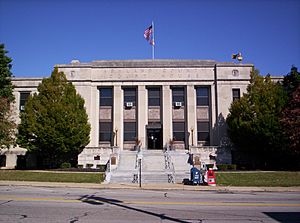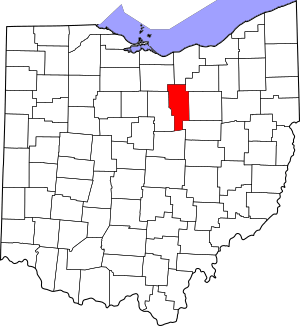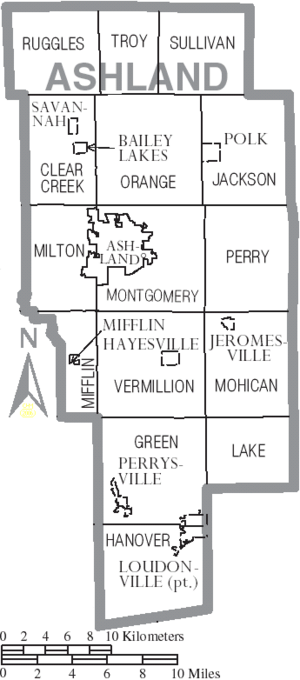Ashland County, Ohio facts for kids
Quick facts for kids
Ashland County
|
|||
|---|---|---|---|

Ashland County Courthouse
|
|||
|
|||

Location within the U.S. state of Ohio
|
|||
 Ohio's location within the U.S. |
|||
| Country | |||
| State | |||
| Founded | February 24, 1846 | ||
| Named for | "Ashland", Henry Clay's home | ||
| Seat | Ashland | ||
| Largest city | Ashland | ||
| Area | |||
| • Total | 427 sq mi (1,110 km2) | ||
| • Land | 423 sq mi (1,100 km2) | ||
| • Water | 3.8 sq mi (10 km2) 0.9%% | ||
| Population
(2020)
|
|||
| • Total | 52,447 |
||
| • Density | 120/sq mi (50/km2) | ||
| Time zone | UTC−5 (Eastern) | ||
| • Summer (DST) | UTC−4 (EDT) | ||
| Congressional district | 4th | ||
Ashland County is a county located in the northeastern part of the U.S. state of Ohio. As of the 2020 census, about 52,447 people live here. Its main city and county seat is Ashland. The county is named after "Ashland", which was the home of a famous senator named Henry Clay near Lexington, Kentucky. Ashland County was created in 1846 from parts of Huron, Lorain, Richland, and Wayne Counties.
Ashland County is part of the Ashland, OH Metropolitan Statistical Area. This area is also included in the larger Mansfield-Ashland-Bucyrus, OH Combined Statistical Area.
Contents
History of Ashland County
Ashland County was officially formed on February 24, 1846. It was made from pieces of Huron, Lorain, Richland, and Wayne counties. Like its main city, Ashland County was named after "Ashland," the home of Henry Clay. He was a very popular senator from Kentucky.
Henry Clay was well-liked in this part of Ohio. He helped solve big disagreements in the country, like the Missouri Compromise in 1820 and the Nullification Crisis in 1833. These events were about keeping the states united and avoiding conflict. Many early settlers in this region came from New England. They strongly supported Henry Clay and were against slavery and states leaving the country. The first non-Native American settlers in Ashland County came from Windham County, Connecticut. Later, from 1800 to the mid-1820s, most new people came from rural Massachusetts, New Hampshire, and Maine.
Geography of Ashland County
According to the U.S. Census Bureau, Ashland County covers a total area of 427 square miles. Out of this, 423 square miles is land, and about 3.8 square miles (0.9%) is water.
Counties Next to Ashland County
Ashland County shares borders with these other counties:
- Lorain County (north)
- Medina County (northeast)
- Wayne County (east)
- Holmes County (southeast)
- Knox County (southwest)
- Richland County (west)
- Huron County (northwest)
Population and People
| Historical population | |||
|---|---|---|---|
| Census | Pop. | %± | |
| 1850 | 23,813 | — | |
| 1860 | 22,951 | −3.6% | |
| 1870 | 21,933 | −4.4% | |
| 1880 | 23,883 | 8.9% | |
| 1890 | 22,223 | −7.0% | |
| 1900 | 21,184 | −4.7% | |
| 1910 | 22,975 | 8.5% | |
| 1920 | 24,627 | 7.2% | |
| 1930 | 26,867 | 9.1% | |
| 1940 | 29,785 | 10.9% | |
| 1950 | 33,040 | 10.9% | |
| 1960 | 38,771 | 17.3% | |
| 1970 | 43,303 | 11.7% | |
| 1980 | 46,178 | 6.6% | |
| 1990 | 47,507 | 2.9% | |
| 2000 | 52,523 | 10.6% | |
| 2010 | 53,139 | 1.2% | |
| 2020 | 52,447 | −1.3% | |
| U.S. Decennial Census 1790–1960 1900–1990 1990–2000 2020 |
|||
What the 2010 Census Showed
In 2010, there were 53,139 people living in Ashland County. There were 20,196 households, which are groups of people living together. The population density was about 125.6 people per square mile.
Most people in the county were white (97.3%). Other groups included Black or African American (0.7%), Asian (0.5%), and American Indian (0.2%). About 0.9% of the population was of Hispanic or Latino origin. Many people had German (32.7%), English (26.2%), or Irish (11.2%) backgrounds.
About 30.9% of households had children under 18 living with them. Many households (55.6%) were married couples. The average age of people in the county was 39.3 years old.
Transportation
The Ashland County Airport is located about 3 miles northeast of the center of Ashland. It helps people travel by air in the area.
Ashland County Park District
The Ashland County Park District was started in 2002. It helps manage and protect natural areas for everyone to enjoy. Stephanie Featheringill is the current director. The park district has 18 parks across the county. They often have special events, like monthly bird walks at Byers Woods Park. You can find a full list of events on the park district's website.
Communities in Ashland County
City
- Ashland (This is the county seat, where the main government offices are.)
Villages
Townships
- Clear Creek
- Green
- Hanover
- Jackson
- Lake
- Mifflin
- Milton
- Mohican
- Montgomery
- Orange
- Perry
- Ruggles
- Sullivan
- Troy
- Vermillion
Census-designated place
- Cinnamon Lake
Unincorporated communities
See also
 In Spanish: Condado de Ashland (Ohio) para niños
In Spanish: Condado de Ashland (Ohio) para niños




